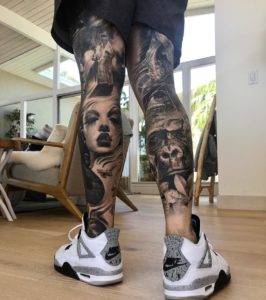I got my first tattoo when I was sixteen. It was a Bible verse tattooed on my chest. I swore to my parents that I wouldn’t regret it. Since it was scripture, I figured I could talk them into letting me get it, and since I was only sixteen I needed their consent to get a tattoo.
Although I never really regretted that tattoo, my plan changed as I discovered more and more about what was possible in the world of skin art.
When I got that first tattoo I had no idea that I would someday cover most of my body with tattoos. I’ve since had over 600 hours under the needle, and have learned some tough lessons along the way.
Beginning a tattoo collection can be overwhelming at first when there are so many possible directions that you can go. It can be difficult deciding what theme you want to go with (if you want one at all), which artist(s) to select, the imagery, their placement, the size etc. It can be easy to become hasty and make decisions you may later look back on and kick yourself about.
Although I’m at a place now where I’m very happy with my collection, there are still plenty of things I wish I could hit the rewind button on. I am someone who believes that it’s good to learn from your own mistakes, but it’s even better when you can learn from the mistakes others have made… especially when those mistakes involve pain, money, and a lot of headaches.
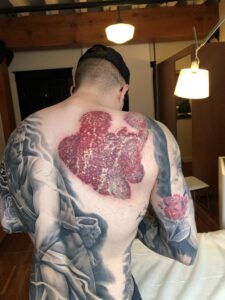

Here are some of the hard lessons I’ve learned along the way. (including lasering off this large color tattoo of Ted Mosby from “How I Met Your Mother.” Don’t ask…)
1.) Choose Your Tattoo Artist Wisely
This is probably the single most important lesson I’ve learned.
Choosing the right artist for your tattoo is something you don’t want to rush. You’d be wise to research, ask questions, find someone whose style best matches what you are going for, and who is someone you can trust.
Social media has changed the industry of tattooing a lot. What you see obviously isn’t necessarily what you’ll get. If you base your decision solely on what artists photos look like on Instagram, you are setting yourself up for a potential fiasco. This is important to understand.
I came to the realization a few years back that often times top notch, legendary artists who are highly respected inside the industry don’t even necessarily have a lot of followers. There are tattooers out there with 5,000 – 10,000 followers who in my personal opinion are creating just as amazing tattoos as plenty of artists with hundreds of thousands of followers.
And sometimes artists with hundreds of thousands of followers may not be accurately representing the quality of their work, which can clearly be misleading.
This may be the case because in my opinion many of the truest and most authentic artists only care about putting out the best work they possibly can, and aren’t all too concerned with their social media other than the business aspect of it. You should never make the decision of who you go to simply based on the number of followers they have on social media, because this is often times a very irrelevant measurement when it comes to the quality of work you’re receiving.
Do your research, study their work carefully without looking at the number of likes or followers, and try to make sure you like about 80% or more of the work on their page before you decide if you want to get tattooed by them.


2. Don’t base your desisions on the advice and opinions of people that don’t have to live with the results.
Tattoo collectors often get excited about upcoming pieces and projects and want to share the news/plans with peers, friends, and family. I’ve been there.
One thing I’ve learned is that everyone has an opinion, especially on tattoos. Don’t base your decisions on the advice and potentially uneducated thoughts of people that don’t have to live with the results.
While it can be great to get feedback from someone you really trust on a specific subject, make sure you are doing your own homework, using your own discretion, and making your own tattoo decisions because at the end of the day it’s you that will be living with the art on your skin potentially forever.


3. Have a plan.
This is something that I’ve had to learn the somewhat hard way. I have gone into some parts of my tattoo journey without an overall plan, and in restrospect I could have saved myself a lot of trouble had I planned things better.
I personally believe it can be a bad idea to start a project (arm-sleeve, leg-sleeve, back piece) without planning that entire section of your body out before you and the artist begin.
Some people like to allow the project to grow more organically as life ebbs and flows, and that can work well too, but for me personally I think having an overall plan can render an overall better end result of the tattoo project.
Like I mentioned before, it can be overwhelming deciding which artist(s) to work with, because there are tens of thousands of amazing tattooers, and it can be very fun to collect different styles from artists who specialize in different things.
In my personal opinion though, I believe it looks best aesthetically when you select a specific artist (or maybe a few) for each project (I.e. a leg-sleeve, arm-sleeve, back-piece) and collect tattoos that fit the body part properly and that the anatomy of them makes sense.
You most likely don’t want just a bunch of random tattoos floating around on your body awkwardly that you have to try to somehow connect together later down the road. I understand some people might like that approach but I assume those people probably aren’t reading this.


4. Communication is Key
Since a tattoo is something you will likely have for your entire life, honest, clear and precise communication between you and your artist is critical. This is one key thing that I’ve had to learn over the years.
I paid the price a few times for not communicating clearly with an artist. There were times that very talented artists and I weren’t on the same page, and I feel one reason why was because I did not communicate as clearly as I should have.
Learning to ask the right questions, clearly communicate your vision, and also utilizing the specific expertise of the artist will go a long way.
Some things to consider:
Where do you want your tattoo?
What size do you want your tattoo to be?
Do you want black and grey or color?
What do you want your tattoo to look like? Have references, ideas in words, and any photos you can find to help further the inspiration for the piece. (But never ask your artist to copy someone else’s work)
What is the budget for your tattoo? Is it best to start the project now or should we wait until my financial situation is more in order?
What is the time frame?
As long as you prepare as much as possible on your end, and clearly communicate with your artist, you are most likely going to be happy with the result.
If you’re someone that is spontaneous and has an artist that you have total trust in, you might consider a “free-reign” piece. I personally love the concept of free-reign work, which means that you allow the artist to choose the direction of the piece and create their vision and original artwork. This takes a tremendous amount of trust, and certainly isn’t something I would reccomend to everyone especially if you’re picky and indecisive.
Even with free-reign work, in my opinion it can still be important to communicate some things in advance such as your overall goal for the aesthetic of your collection, as well as if there is any subject matter that’s off limits. That way, you don’t show up on the day of and disagree completely on what you and the artist each envisioned the tattoo to be.
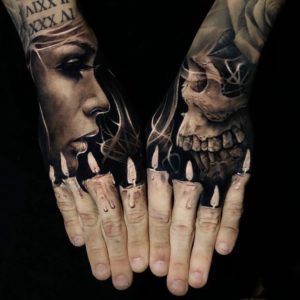

5. Just because you can’t afford the whole project at the moment, doesn’t mean you should cut corners and rush things.
I have done this multiple times.
I couldn’t afford the whole project at the time, so instead of planning the whole thing out and taking baby-steps in the right direction, I rushed and pushed to begin the project without a real plan, hoping things would somehow work out in the end.
Because I was hasty, I wasn’t happy with the work and ended up laser removing certain tattoos. So in the long run, I ended up spending more money and having to endure the pain and hassle of laser removal.
Again, if you want an overall large scale bodysuit aesthetic, I believe it’s in most people’s best interest to go slow. That way, you are able to make sure everything you collect is quality work and cohesive.


6. There’s no rush.
When I found out about the realism genre and became a true collector of this art form, things got very exciting and I became a man on a mission wanting beautiful art on nearly every square inch of my body.
While I’m extremely happy with the majority of my collection, it can be bittersweet running out of room, and sometimes wonder if I did a few things differently.
It’s a marathon not a sprint. The quality of tattoo art is only getting better as the years go on so take your time, plan things out, and enjoy the ride.
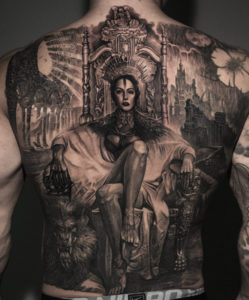

7. Consider The Cohesion of Your Aesthetic
If a cohesive aesthetic is the goal for your collection, focus on large projects rather than just the amount of artists you want to collect from.
I currently have collected work from over 30 different people, and take great pride in the fact that my bodysuit consists of work from so many talented artists.
One of my personal goals with my collection though, is for it to resemble a museum on the human body. It’s fun to see all of the different distinct styles of each artists on us collectors bodysuits.
However, complications may arise when wanting to collect work from a plethora of artists, rather than focusing on each of your projects specifically. Potential problems may include interruption of flow and cohesion between different artists, lack of an overall cohesive theme, as well as the general potential possibility of having different pieces look like they don’t fit in well with your other tatttoos.
Take a look at this back piece done entirely by Robert Pho. It’s a great example of how cohesive the work looks when done by one artist. Something to consider when you plan your projects.
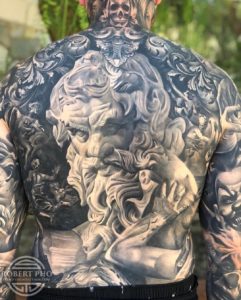

With all that being said, the last thing to really keep in mind is that there are no official rules when it comes to tattoo collecting, which is half of the beauty if you ask me.
While I can sit here and tell you about lessons I’ve learned, and things I’ve observed through my personal experience, at the end of the day each person has their own story to tell and their own vision for what they want their collection to look like. It’s a journey of our own, and no two tattoo journeys are ever the same.
Thanks for reading. Be sure to check us out on Instagram @leadthefollowers, as well as my personal page @jordanfeno.
